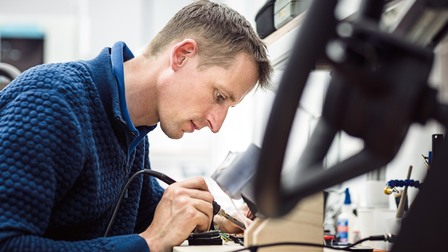
Design ing for the Future
Unmistakable: The round instruments with the tachometer in the center are a
Style
“The main difference between a
The brand’s stylists, at their new design center in Weissach, are very clear about their priorities when it comes to defining the aesthetic and functional orientation of the interior. The
![[+]](https://staging.www.porsche.com/filestore/image/multimedia/none/christophorus-issue384-article01-content-01/normal/261e3874-c523-11e7-b591-0019999cd470/porsche-normal.jpg)
Jochen Leinberger
Teamwork: Ivo van Hulten, head of interior design, brought together a group of people with a variety of skills.
Mauer sketches out
The 911 as point of reference
The primary objective is always a fascinating driving experience. The user experience is the focus of all the work that goes into the car. All research begins with a look back at the past. Using the example of a 1973 911 T, designer Thorsten Klein describes the elements that make the interior of a
Salar Vakili
“Our task,” says Mauer, “isn’t to linger reverently in the past but to further develop the company’s distinctive identity for the future. Retaining the essence and translating it into a design language that’ll be understood in the future.” And even those who first sit in a
Ivo van Hulten has been the head of interior design with
Solutions that increase driving pleasure
The scope of the interior design encompasses not only how displays are designed but also what’s seen on them. Gantimur Meissner’s business title is Director of UX/UI
![[+]](https://staging.www.porsche.com/filestore/image/multimedia/none/christophorus-issue384-article01-content-02/normal/564b0091-c523-11e7-b591-0019999cd470/porsche-normal.jpg)
When it’s time to assess the results, Chief
User experience:
If an idea—generally recorded in the form of simple sketches—is so good that it merits testing, an interactive prototype is created for the second acronym, UI—as in “user interface.” In the process, concept developers, designers, engineers, electronics experts, programmers, and modelers work hand in hand. They’re an integral part of Michael Mauer’s team in Weissach. Meissner has a lofty standard: “We want to be the place where technology and design flow together, melding into a perfect user experience.”
Taking a seat with data glasses
The world of design is an increasingly digital one, yet the beginning of every
Once the broad strokes are clear, the style experts return to the analog world. Form and function alone don’t define the interior environment. Colors and materials are necessary to complete the overall appearance. But what does that mean? What materials will embody sportiness after 2020? Will they be classic high-tech materials such as aluminum and carbon or natural materials like wood and leather, whose surfaces are allowed to age over the course of time? Patina as an expression of modernity?
![[+]](https://staging.www.porsche.com/filestore/image/multimedia/none/christophorus-issue384-article01-content-03/normal/7390755d-c523-11e7-b591-0019999cd470/porsche-normal.jpg)
Christopher Gutierrez Diaz
Michael Mauer finds this tangible uncertainty stimulating when contemplating the future. Everything changes. “For creatives, this acceleration in the pace of change is an inspiring state to be in.” The design team is trained in the art of anticipating what’s to come and imagining the world of tomorrow. Mauer, too, was thinking ahead when he assembled his team years ago. “We have more generalists on board, to think further ahead,” he says, while his right hand—as it so often does—draws a 911. The line of tomorrow? “Perhaps,” answers Mauer, who then laughs and folds up the piece of paper. Even in 2048, when the
Mauer generally explains his preference for a particular variant with the following sentence: “That’s the one that gives me the best gut feeling.” A feeling that can only be sensed intangibly in the virtual world, notwithstanding the ever-more-realistic representations it enables—and the reason why perfectly handcrafted modeling will continue to be valued, even as the digital future unfolds.
![[+]](https://staging.www.porsche.com/filestore/image/multimedia/none/christophorus-issue384-article01-content-04/normal/8fac5dcc-c523-11e7-b591-0019999cd470/porsche-normal.jpg)
For Daniela Milosevic, it’s all about the haptics: Natural materials are becoming increasingly important in the digital age.
By Johannes Winterhagen
Photos by Thorsten Doerk
![[+]](https://staging.www.porsche.com/filestore/image/multimedia/none/christophorus-issue384-article01-margin-01/normal/16ecab52-c523-11e7-b591-0019999cd470/porsche-normal.jpg)
![[+]](https://staging.www.porsche.com/filestore/image/multimedia/none/christophorus-issue384-article01-margin-02/normal/38980c57-c523-11e7-b591-0019999cd470/porsche-normal.jpg)
![[+]](https://staging.www.porsche.com/filestore/image/multimedia/none/christophorus-issue384-article01-margin-03/normal/4c1c7aaa-c523-11e7-b591-0019999cd470/porsche-normal.jpg)
![[+]](https://staging.www.porsche.com/filestore/image/multimedia/none/christophorus-issue384-article01-margin-04/normal/67185c40-c523-11e7-b591-0019999cd470/porsche-normal.jpg)
![[+]](https://staging.www.porsche.com/filestore/image/multimedia/none/christophorus-issue384-article01-margin-05/normal/88883acc-c523-11e7-b591-0019999cd470/porsche-normal.jpg)













